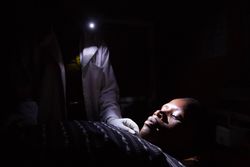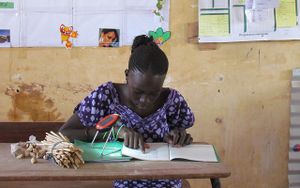Knowledge fuels change - Support energypedia!
For over 10 years, energypedia has been connecting energy experts around the world — helping them share knowledge, learn from each other, and accelerate the global energy transition.
Today, we ask for your support to keep this platform free and accessible to all.
Even a small contribution makes a big difference! If just 10–20% of our 60,000+ monthly visitors donated the equivalent of a cup of coffee — €5 — Energypedia would be fully funded for a whole year.
Is the knowledge you’ve gained through Energypedia this year worth €5 or more?
Your donation keeps the platform running, helps us create new knowledge products, and contributes directly to achieving SDG 7.
Thank you for your support, your donation, big or small, truly matters!
Gender Impacts of Energy Access
Overview
Lack of access to energy has a clear impact on communities because inadequate energy infrastructure causes the marginalization of entire villages or cities. At the same time, energy poverty strongly affects the individual’s living and social conditions and undermines educational and business opportunities.
Women in these areas, typically responsible for a household’s energy supply, suffer the greatest impact of energy poverty. Evidence of this can be found in observable consequences such as health or physical drudgery, as well as in terms of social inequality and limited personal empowerment.
Direct Impacts on Gender
Health
Lack of access to modern energy is responsible for over 4 million premature deaths every year[1] and has a strong impact on women’s health as they are commonly responsible for ensuring the daily energy supply for cooking and heating.
Women who cannot rely on modern cooking facilities still burn traditional biofuels (wood, agricultural residues, human and animal waste) for domestic purposes. When electricity is not available, candles, kerosene, or alternative and highly polluting fuels are used for lighting. The improper usage of fuels, along with scarce indoor ventilation has serious consequences on health and increases the risk of stroke, pneumonia, lung disease and cancer, asthma, bronchitis and ischemic heart disease. Women and children suffer the most from respiratory diseases, as they spend much time indoors. Studies have shown that burning traditional biofuels for domestic use increases the risk of pneumonia by 80% compared to the use of clean cooking facilities and doubles the chances of developing lung disease and lung cancer[2].
Furthermore, women lacking access to modern cooking facilities are responsible for firewood collection. The International Energy Agency (IEA) estimated that the average firewood load carried by women for several miles daily varies from 25 – 50 kg[3] [4]. Such physical labour not only represents a poor use of women’s and young girls’ time, but it also has negative consequences on their postures and can cause back and muscle pain.
Accessing electricity is not sufficient to supply a household’s energy demand as it is not used for cooking purposes. Improvements in women’s health, however, are still possible when indoor electricity is available. Indoor electricity prevents the burning of candles, kerosene and other highly polluting fuels and permits the use of refrigerators and televisions. Owning a refrigerator reduces the risk of food poisoning by enabling food conservation. Television has an important role in empowering women and girls. While watching TV, women and young girls are exposed to new social roles, a plurality of information, higher health and hygiene standards, and so on. Women exposed to TV regularly at home have been found to be healthier than those without televisions. Furthermore, exposure to additional information and social norms increases women’s intolerance of domestic violence, resulting in a higher number of divorces and a lower birth rate[2].
Access to electricity in hospitals and health centres is also crucial because refrigerators can store medicines, vaccines, etc. and provide a safe birth environment at night. Health structures’ electrification is therefore responsible for lowering mortality rates, increasing the quality of healthcare services and improving life expectancy. Currently, almost 60% of sub-Saharan Africa’s health facilities have no electricity at all.[3]
Safety
Electrification of public spaces, such as streets and squares, has a positive impact on women’s security because it decreases the crime rate and physical and sexual violence. The positive correlation between public lighting and women’s perception of safety is also important. When women do not feel secure walking alone before dawn or after sunset, they restrict their activities and movements, reducing personal empowerment and affecting educational and business opportunities.[4]
Education
Access to electricity is also found to have a strong connection with girls’ education.
Having electricity at home and in schools allows for studying and reading at night, watching TV and therefore accessing multiple information sources.
Worldwide, women and young girls lacking access to modern energy spend on average 1.4 hours per day collecting firewood, and several hours cooking and heating their houses.[3] In Sierra Leone and in Nigeria, fuel collection can take, on average, 5 hours per day.[3] This time could be employed in more productive and empowering activities, such as going to school.
Several studies demonstrated that access to electricity increases girls’ school attendance and educational attainment levels. In Brazil, chances of concluding primary school by the age of 18 are 60% higher for girls with access to electricity than those without.[3]
Given the positive correlation between access to electricity andhigher educational outcomes, the first can also be considered as a contributing factor in preventing child marriage. Girls in secondary school are up to six times less likely to marry, compared to those with no or little education.[4]
Education is also considered one of the most important drivers of psychological and economic empowerment and essential for poverty eradication and the fostering of gender equality. More than 90 million children in sub-Saharan Africa attend schools with no access to electricity, hindering their educational and economic prospects.[3]
Economic Development & Empowerment
Modern and reliable energy is also essential for economic development and women’s empowerment. Time saved from wood and fuel collection could be effectively used for new business opportunities. In South Africa, female employment in newly electrified communities rose by almost 10% because of the improved efficiency in carrying out domestic tasks.[3]
Access to electricity also acts as a revenue multiplier: the income of self-employed women with access to modern energy is more than two times higher than the income of women relying on traditional sources. Furthermore, women who have access to electricity and are exposed to several information channels, i.e. TV or formal education, are also more likely to be externally employed. In Nicaragua, electrification has raised the number of women from rural communities to work outside their home by 23%.[3]
As women contribute to the household’s income, they also benefit from personal empowerment, increase their bargaining and decision making power domestically and improve their social status outside the home. In this way, women’s economic and personal empowerment results in higher social influence and greater political awareness. Both of these aspects are necessary to overcome the traditional gender-based division of labour.
While access to modern energy generally has clear and positive effects on females’ employment and empowerment, it might initially decrease income generation opportunities. Firewood collection and sales represent a source of income for women that would disappear in the case of technological advancement and a switch to modern energy. However, electrification is also responsible for increasing efficiency and automation in different sectors, including agriculture, where women are traditionally employed.[3] The agricultural workforce could then be redirected or re-qualified in different sectors.
Potential Measures & Solutions
As women are often primary energy users, it is important that their specific needs and requirements are met in the market. Having women employed in different segments of the energy supply chain and actively involved in energy production, bring significant economic advantages. As women are more aware of the households’ energy needs, they also tackle them more effectively, designing more adequate solutions, technologies, services and policies. Such awareness also increases women’s capability and authority in influencing their peers when promoting cleaner cook stoves or decentralised solutions to produce electricity. This speeds up the process to obtain universal access to clean and modern energy.
Studies also demonstrated that women re-invest 90% of their income in their families (mostly on children’s education) and communities, against 30 % - 40% of men.[5] Women earning an income, therefore, represent an economic and social trigger and play an important role in poverty eradication.
Three main areas of action and best practices have been developed to ensure women’s participation and contribution in the energy sector :[5]
- “Engendering” energy projects, programs, and policies: ensuring that general benefits and gender equality are maximised in each project or policy design, by taking into account women’s and men’s different roles, access and control over resources. Several multinational actors (development banks, regional organisations, international organisations, donors, etc.) are now mainstreaming gender and supporting best practices. New initiatives, such as Global Alliance for Clean Cookstoves, SEforALL, ECOWAS Energy-Gender Policy & Regulation, ENERGIA and the Clean Energy Ministerial, advocate for and address universal access to energy, health and climate change resources, along with women’s empowerment, employment and gender equality. These initiatives are also meant to support policy makers and institutions to tackle energy barriers more efficiently and design effective interventions.
- Empowering women as energy entrepreneurs and engaging their trusted network to deliver and spread more effective energy service and products. Women can, in fact, play a key role in promoting, financing and selling off grid devices - which can, at the same time, expand access to modern energy, popularise clean energy and generate income for women.
- Supporting financial inclusion, pricing and subsidies: to give women the opportunity to buy clean energy devices and provide them access to credit. Women, or female-owned business, have a lower rate of obtaining loans and at times the possibility is zero. Global Findex shows that in developing countries, women are 20% less likely than men to have a bank account and 17% less likely to have formally borrowed money in the past year. Women also face higher interest rates and are usually offered short-term loans.[5]
Conclusion
Overall, a combination of decreasing costs related to solar and decentralised solutions make access to clean and more efficient energy easier. New business models, relying on digital and mobile-enabled platforms, have also amplified the available solutions to improve access to energy and credit. Yet, diffusion of clean cooking facilities remains rather limited. This is mostly due to traditional customs (specific ways of cooking traditional food), resistance to ending biofuel usage, as well as inability to afford new cook stove fuels that have higher maintenance costs in the long run. On the other hand, major awareness about clean cooking’s benefits should be raised, both in local and international political agendas.
Energy stakeholders, which include governments and private donors, should also pay specific attention to infrastructure development and ensure electrification of public spaces, schools and health centers. These are to be considered both ameliorative and preventive measures to provide women a better education, safety and higher standards of living conditions.
Further Information
- Other articles on Gender Impacts of Energy Access
- The Role of Gender Concerns in the Planning of Small-scale Energy Projects in Developing Countries
- Strengthen Women’s Capacity to Participate in and Benefit From Energy Markets
- Integrating Gender Issues into Energy Projects
- Energy Access Portal
- Socio-economic impact of access to energy
References
- ↑ World Health Organization (2016). Household Air Pollution and Health, Media Centre, Fact Sheet N° 292. Available online at: http://www.who.int/mediacentre/factsheets/fs292/en/
- ↑ 2.0 2.1 Gunnar K. et al. (2011). Energy, Gender and Development. What are the Linkages? Where is the Evidence?, The World Bank Sustainable Development Network, Research Working Paper 5800. Available at: https://openknowledge.worldbank.org/bitstream/handle/10986/3564/WPS5800.pdf;sequence=1
- ↑ 3.0 3.1 3.2 3.3 3.4 3.5 3.6 3.7 3.8 International Energy Agency (2017). Energy Access Outlook – From Poverty to Prosperity, World Energy Outlook Special Report. Available online at: https://www.iea.org/publications/freepublications/publication/WEO2017SpecialReport_EnergyAccessOutlook.pdf
- ↑ 4.0 4.1 Power Africa (2017). Exploring the Relationship Between Energy Access and Gender-Based Violence. Available online at: https://medium.com/@PowerAfrica/exploring-the-relationship-between-energy-access-and-gender-based-violence-ee8d9e320437
- ↑ 5.0 5.1 5.2 Soma D. et al. (2017). Energy Access and Gender - Getting the Right Balance, SEAR Special Feature, The World Bank. Available online at: http://documents.worldbank.org/curated/en/463071494925985630/pdf/115066-BRI-P148200-PUBLIC-FINALSEARSFGenderweb.pdf
|
This article is part of the Energy Access Portal which is a joint collaboration between energypedia UG and the “World Access to Modern Energy (WAME)". WAME is managed by the Museo Nazionale della Scienza e Tecnologia Leonardo da Vinci (MuST), the Fondazione AEM and the Florence School of Regulation (FSR) and it is supported by Fondazione CARIPLO. |
Written by: Ilaria Bellacci,Research Associate, Florence School of Regulation
























